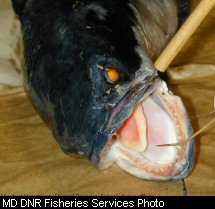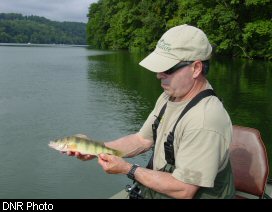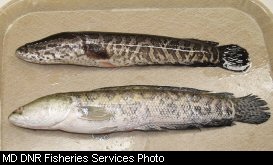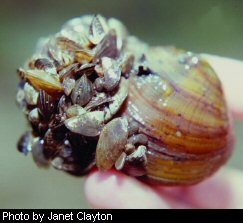

Attack of the Alien InvadersBy Frank Jernejcic
A fish or plant may be a desirable native or indigenous organism in one state or body of water, but undesirable or exotic in another state, or even in a different lake or river within the same state. For example, the brook trout is a desirable sport fish in West Virginia , but is considered an alien species that competes with native rainbow trout in western states. Other popular sport fish that are considered beneficial in one state but a nuisance in another are the brown and rainbow trout, flathead catfish, northern pike and smallmouth bass. Freshwater drum, common in the Monongahela River , were recently found in Tygart Lake and may prove to be detrimental to the lake's plant and animal communities. What are the impacts of nuisance species? In their native waters, these organisms may be relatively harmless. When transplanted to other waters, however, they can cause problems for native organisms by altering habitats, introducing diseases, creating excessive competition for food and space, or diluting gene pools through hybridization. The end result can be the decline or elimination of a desirable fish population with significant economic impacts for all who use, or otherwise benefit from, these aquatic ecosystems. Once established, elimination of an introduced species is nearly impossible. Tens of millions of dollars are spent annually on nuisance species prevention and control throughout the United States . Some of the best-known examples of aquatic nuisance species are: the common carp; the sea lamprey infestation of the Great Lakes ; zebra mussels in the Great Lakes , Mississippi and Ohio river basins; and the aquatic plants, hydrilla and water hyacinth, found throughout the southern and western coasts. A lesser-known example is a parasite that causes whirling disease in trout in the northeastern and western states. During the last few years, the snakehead fish and three species of Asian carps -- the bighead, black, and silver -- have received national publicity and are a major concern of state fishery agencies throughout the country. How did these organisms reach North America ? The single largest source of unintentional introductions is through ballast water discharged by ships from foreign ports, particularly Eurasia . Other major pathways for introductions are the aquaculture (fish farming) industry, The biggest threat to North American sport fish populations since the introduction of the common carp in 1877 is unfolding right now near Chicago . Last spring a temporary electrical barrier was constructed in the Chicago Sanitary and Ship Canal, which connects the Great Lakes watershed with the Mississippi River basin . The barrier is designed to prevent fish from moving between the two watersheds that would result in billions of dollars of irreversible impacts to aquatic ecosystems. Biologists are most concerned with the round goby, tubenose goby, ruffe, spiny waterflea and quagga mussel moving downstream into the Mississippi River basin, and the three Asian carps moving upstream into the Great Lakes. It is likely these Asian carps will eventually reach West Virginia . The “poster child” for aquatic nuisance species is the zebra mussel that entered the Great Lakes through ballast water transfers in 1986 and moved rapidly into the Mississippi watershed on barges. Zebra mussels compete with native clams and have altered the water quality of the Great Lakes by their filtering ability. It costs water-using industries more than $2 billion annually to clean zebra mussel colonies from their intake and discharge pipes. They are well established in West Virginia 's reach of the Ohio River but have not been found in our inland lakes. A second “poster child” is the snakehead fish. Found originally in a 4-acre pond in Maryland in 2002, it has also been found in the Potomac River drainage in Virginia . A study is underway to determine their distribution and if they are reproducing. These fish were eventually eliminated with a fish toxicant but not before generating a great deal of national publicity. This led to their listing as an injurious species under the federal Lacey Act which prohibits their importation and interstate transportation. The Non-indigenous Aquatic Nuisance Prevention and Control Act of 1990 provided a mechanism for establishment of regional panels by the national Aquatic Nuisance Species Task Force to address pertinent issues. Five panels have been In response to the nuisance species threat and concerns about the spread of largemouth bass virus, the West Virginia legislature enacted a bill in 2003 to give the DNR the authority to regulate fish stocking in public waters. The West Virginia B.A.S.S. Federation requested and supported the bill as a means to reduce the potential spread of largemouth bass virus within the state. The virus is carried by several fish species, but has produced disease only in largemouth bass. It does not affect humans. It has been found in about 20 states and has resulted in minor and sporadic fish kills since 1995. Largemouth bass from 10 West Virginia waters were tested in 2003 and only one positive sample was found at Sutton Lake . The new law is also intended to prevent the stocking or transfer of fish into and among state rivers and lakes. Anglers have stocked fish either inadvertently by emptying a bait bucket, or purposefully to provide another species to catch. However, introduced fish can compete with native or established sport fish for food and habitat with unforeseen consequences. Freshwater drum were discovered in Tygart Lake in 2002 and was the fourth species likely stocked by anglers in Tygart . Yellow perch were found in Teter Creek Lake for the first time last summer. The perch are stunted and do not provide a sport fishery but are competing with young bluegills and largemouth bass for food. A greater threat will occur when silver carp move into the West Virginia portion of the Ohio River . Anglers commonly collect young-of-the-year gizzard shad for bait. Young-of-year silver carp are very difficult to distinguish from these It is now illegal to release any live or dead fish, or other aquatic organism including eggs, into the public waters of West Virginia without a stocking permit from the DNR. This includes the release of baitfish from bait buckets and the transfer of fish caught legally in one body of water into another lake or river. Trout stocking does not require a permit if the trout originate from a source within the state, or are certified disease free. Black bass -- largemouth, smallmouth and spotted bass -- can be stocked in public waters if they are certified disease free and the DNR is notified prior to stocking. Private ponds may be stocked with native or established species without a permit. The public is the first line of defense against the invasion of alien animals and plants. With your help we can prevent our state's aquatic ecosystems from being harmed and use our financial and personnel resources more effectively to enhance our fishery resources. Frank Jernejcic is the District 1 fisheries biologist stationed in Farmington . |
 What do the common carp and the zebra mussel have in common? They are both aquatic nuisance species which have become established in West Virginia . Unfortunately, they will not be the last. Aquatic nuisance species have many labels: alien, exotic, introduced, invasive, nonindigenous, or nonnative.
What do the common carp and the zebra mussel have in common? They are both aquatic nuisance species which have become established in West Virginia . Unfortunately, they will not be the last. Aquatic nuisance species have many labels: alien, exotic, introduced, invasive, nonindigenous, or nonnative.  aquarium trade, sport fish stocking, bait business, nursery trade, and water gardening. Once in the country, aquatic species are spread by attachment to commercial barge and recreational boats, escape from ponds, and releases from aquaria and bait buckets.
aquarium trade, sport fish stocking, bait business, nursery trade, and water gardening. Once in the country, aquatic species are spread by attachment to commercial barge and recreational boats, escape from ponds, and releases from aquaria and bait buckets.  organized since 1991. West Virginia is an active participant on the Mississippi River Basin Panel. Common goals of the panels are prevention, detection and control of aquatic nuisance species, and public education about these species.
organized since 1991. West Virginia is an active participant on the Mississippi River Basin Panel. Common goals of the panels are prevention, detection and control of aquatic nuisance species, and public education about these species.  gizzard shad and could easily be moved to another West Virginia water by accident.
gizzard shad and could easily be moved to another West Virginia water by accident.